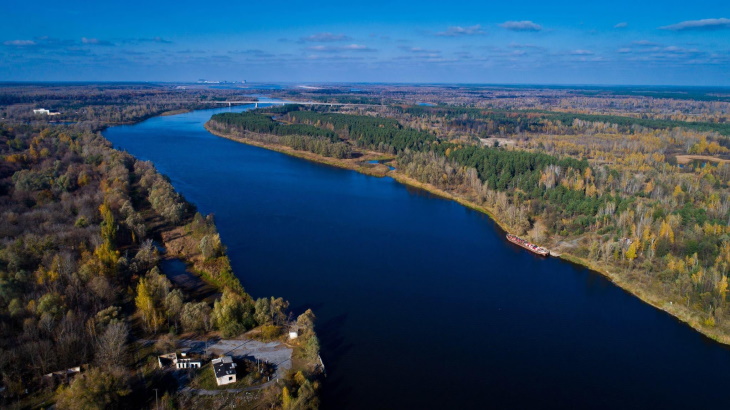Second staff rotation at Chernobyl
The first staff rotation at Ukraine's Chernobyl nuclear power plant in three weeks and only the second since late February when Russian forces seized the site has been carried out. The workers were transported by boat as the plant remains inaccessible by road.

The Pripyat River (Image: Energoatom)
Nuclear power plant operator Energoatom announced on 9 April that it provided its boat for the change of staff at the Chernobyl plant. It said 49 employees were taken by the boat along the Pripyat River to the plant from the city of Slavutych, which lies outside the 30-kilometre exclusion zone. 51 workers were then taken from the plant back to Slavutych. "There are currently no other ways of delivering people to the station from Slavutych," the company noted.
Most of the workers at Chernobyl, including 46 volunteers, had been there since 20 March. However, 13 workers had been on site since 24 February.
International Atomic Energy Agency (IAEA) Director General Rafael Mariano Grossi welcomed the second staff rotation as a much-needed positive step for the well-being of the plant's personnel and their families. He said the shift change was also important for the safe and secure operation of the Chernobyl plant, which was controlled by the Russian military for five weeks until they withdrew on 31 March.
However, he said the fact that those taking part in the latest staff rotation had to be transported to and from the site by boat underlined that the situation at the plant and the exclusion zone around it remained far from normal.
"While it is very positive that Ukrainian authorities are gradually restoring regulatory control of the Chernobyl site, it is clear that a lot of work remains to return the site to normality," Grossi said. "As soon as it is possible, I will head an IAEA mission to Chernobyl to conduct a radiological assessment there, resume remote safeguards monitoring of the facility and its nuclear material and deliver equipment, including spare parts and components, for the plant's safe and secure operation. I'm in close consultations with Ukraine on setting a date and organising a programme of work for the visit, which is expected to take place soon."
The IAEA said on 8 April that it will be the "single point of contact" for international technical assistance to Ukraine and it is in discussions with the many countries that have expressed interest in backing its efforts to help ensure the safety and security of Ukraine's nuclear facilities.
In a 10 April update, the IAEA said it had been informed by Ukraine that the site's analytical laboratories for radiation monitoring were destroyed and the analytical instruments stolen, broken or otherwise disabled. In addition, an associated Information and Communication Centre had been looted, parts of its communication lines destroyed, and the automated transmission of radiation monitoring data disabled.
Ukraine said that following the departure of Russian troops last week, despite "the increase in the level of radioactive contamination ... due to non-conformity with requirements of radiation safety and strict access procedures", the radiation situation is "within the limits" for the site.
In a 9 April IAEA update, Grossi said its experts can only conduct a radiological assessment at the site and deliver required safety-related equipment to the plant when they go there.
Whilst the IAEA has not been receiving remote data transmission from its monitoring systems installed at Chernobyl, it said such data was being received from Ukraine's other nuclear power plant sites.
Regarding the country's 15 operational reactors at four sites, eight are currently connected to the grid, including two at the Russian-controlled Zaporozhe plant, three at Rivne, two at the South Ukraine plant and one at Khmelnitsky. The seven other reactors are shut down for regular maintenance or held in reserve.
Researched and written by World Nuclear News
- China Institute of Atomic Energy
- Nuclear Power Institute of China
- Southwestern Institute of Physics
- China Nuclear Power Operation Technology Corporation, Ltd.
- China Nuclear Power Engineering Co., Ltd.
- China Institute for Radiation Protection
- Beijing Research Institute of Uranium Geology (BRIUG)
- China Institute of Nuclear Industry Strategy (CINIS)
- China Nuclear Mining Science and Technology Corporation


